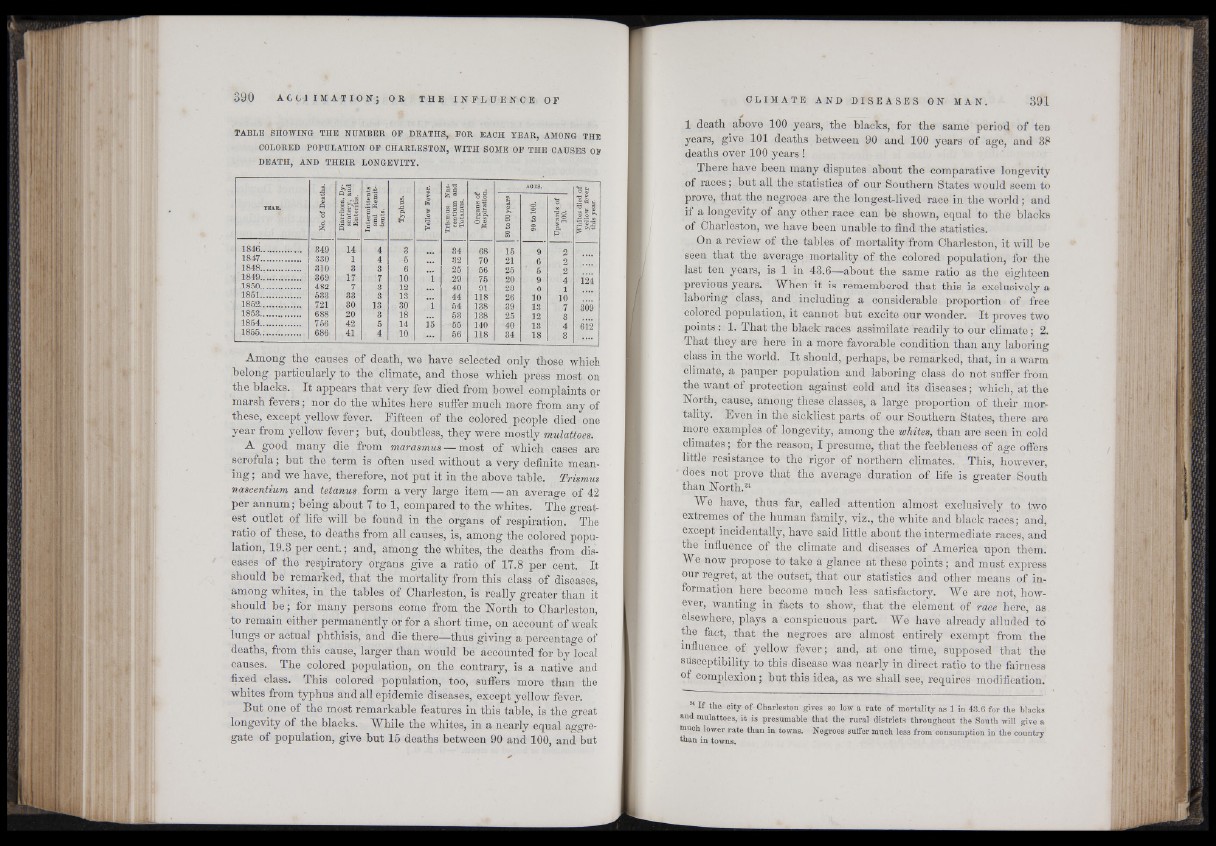
TABLE SHOWING THE NUMBER OF DEATHS, FOR EACH YEAR, AMONG THE
COLORED POPULATION OF CHARLESTON, WITH SOME OF THE CAUSES OF
DEATH, AND THEIR LONGEVITY.
TSAR.
and
No. of Deaths.
Diarrhoea, Dysentery,
Enteritis.
Intermittents
and Remittents.
Typhus.
and
Yellow Fever.
Trismus Nascentium
Tetanus.
Organs of
Respiration.
AGES.
Whites died of
yellow fever
this year.
80 to 90 years
90 to 100.
Upwards of
100. "
1846.................. 349 14 4 3 34 68 2
1847.................. 330 Ì 4 5 32 70 21 6 2
1848.............. 310 3 3 6 25 56 25 S U B 2
1849.................. 369 17 7 10 29 75 20. 9 4 18-50.................. 124 482 7 3 40 91' 23 6 1
1851.................. 533 33 3 23 44 118 26 10 10
1852.................. 721 30 13 i 54 138 39 13 7 309 1853.................. 688 20 3 18 53 138 25 12 3
1854.................. 756 42 5 14 i s . 55 J '140 MüÇ* 13 4 612 1855.:.............. 686 41 4 10 56 118 O r 3
Among the causes of death, we have selected only those which
belong particularly to the climate, and those which press most on
the blacks. It appears that very few died from bowel complaints or
marsh fevers; nor do the whites here suffer much more from any of
these, except yellow fever. Fifteen of the colored people died one
year from yellow fever; hut, doubtless, they were mostly mulattoes.
A good many die from marasmus — most of which cases are
scrofula; but the term is often used without a very definite meaning
; and we have, therefore, not put it in the above table. Trismus
nascentium and tetanus form a very large item an average of 42
per annum; being about 7 to 1, compared to the whites. The greatest
outlet of life will be found in the organs of respiration. The
ratio of these, to deaths from all causes, is, among the colored population,
19.3 per cent.; and, among the whites, the deaths from diseases
of the respiratory organs give a ratio of 17.8 per cent. It
should be remarked, that the mortality from this class of diseases,
among whites, in the tables of Charleston, is really greater than it
should h e ; for many persons come from the North to Charleston,
to remain either permanently or for a short time, on account of weak
lungs or actual phthisis, and die there—thus giving a percentage of
deaths, from this cause, larger than would he accounted for by local
causes. The colored population, on the contrary, is a native and
fixed class. This colored population, too, suffers more than the
whites from typhus and all epidemic diseases, except yellow fever.
But one of the most remarkable features in this table, is the great
longevity of the blacks. "While the whites, in a nearly equal aggregate
of population, give hut 15 deaths between 90 and 100, and hut
1 death above 100 years, the blacks, for the same period of teD
years, give 101 deaths between 90 and 100 years of age, and 38
deaths over 100 years !
There have been many disputes about the comparative longevity
of races; but all the statistics of our Southern States would seem to
prove, that the negroes are the longest-lived race in the world; and
if a longevity of any other race can he shown, equal to the blacks
of Charleston, we have been unable to find the statistics.
On a review of the tables of mortality from Charleston, it will be
seen that the average mortality of the colored population, for the
last ten years, is 1 in 43.6—about the same ratio as the eighteen
previous years. When it is remembered that this is exclusively a
laboring class, and including a considerable proportion of free
colored population, it cannot but excite our wonder. It proves two
points: 1. That the black races assimilate readily to our climate; 2.
That they are here in a more favorable condition than any laboring
class in the world. It should, perhaps, be remarked, that, in a warm
climate, a pauper population and laboring class do not suffer from
the want of protection against cold and its diseases; which, at the
North, cause, among these classes, a large proportion of their mortality.
Even in the sickliest parts of our Southern States, there are
more examples of longevity, among the whites, than are seen in cold
climates; for the reason, I presume, that the feebleness of age offers
little resistance to the rigor of northern climates. This, however,
does not prove that the average duration of life is greater South
than North.24
We have, thus far, called attention almost exclusively to two
extremes of the human family, viz., the white and black races; and,
except incidentally, have said little about the intermediate races, and
the influence of the climate and diseases of America upon them.
We now propose to take a glance at these points; and must express
our regret, at the outset, that our statistics and other means of information
here become much less satisfactory. We are not, however,
wanting in facts to show, that the element of race here, as
elsewhere, plays a ' conspicuous part. We have already alluded to
the fact, .that the negroes are almost entirely exempt from the
influence of yellow fever; and, at one time, supposed that the
susceptibility to this disease was nearly in direet ratio to the fairness
of complexion; hut this idea, as we shall see, requires modification.
24 If the of Charleston gives so low a rate of mortality as 1 in 43.6 for the blacks
and mulattoes, it is presumable that the rural districts throughout the South will give a
much lower rate than in towns. Negroes'suffer much less from consumption in the country
than in towns.